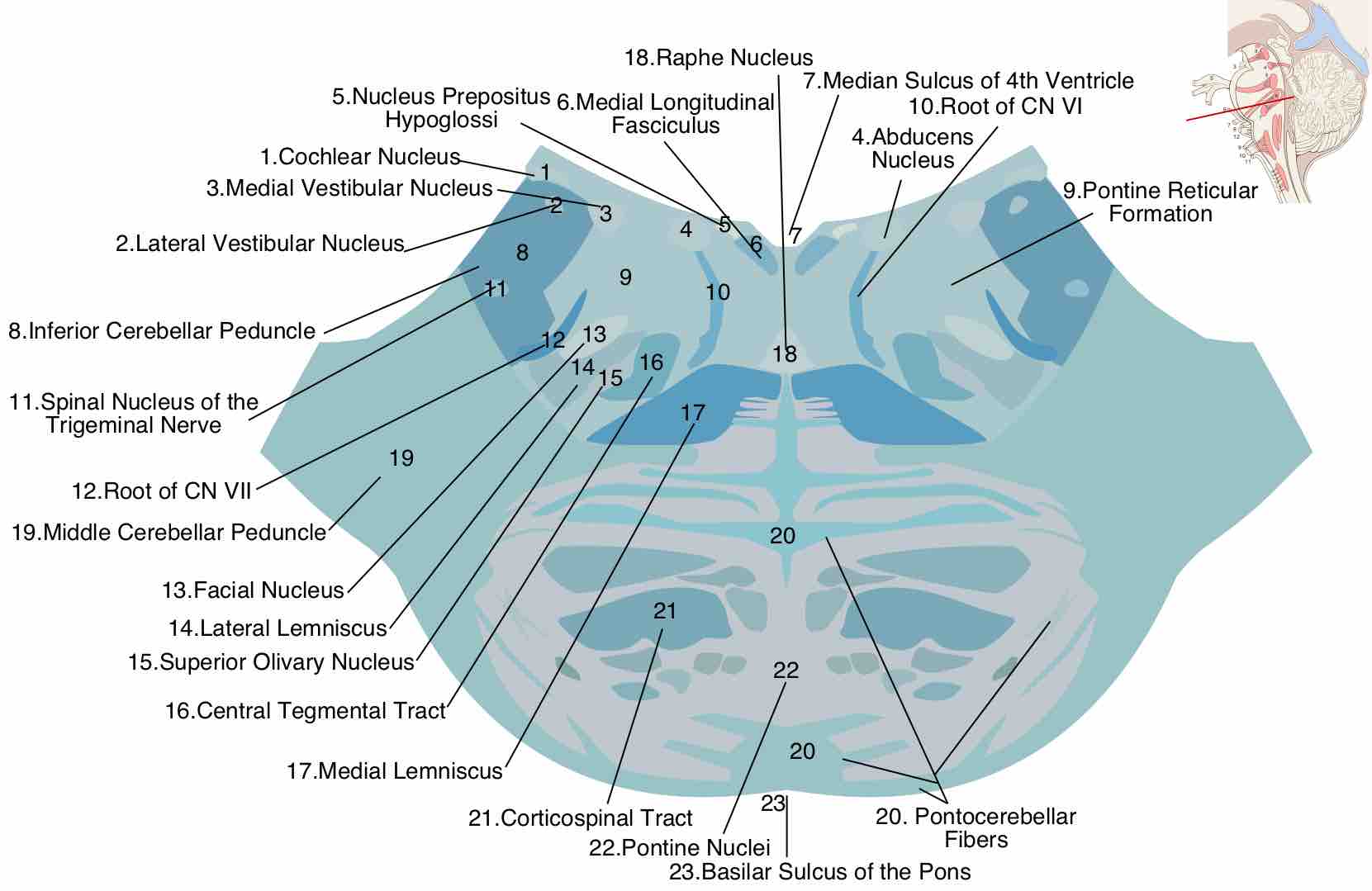The reticular formation is a region in the pons involved in regulating the sleep-wake cycle and filtering incoming stimuli to discriminate irrelevant background stimuli. It is essential for governing some of the basic functions of higher organisms, and is one of the phylogenetically oldest portions of the brain.
Divisions of the Reticular Formation
Traditionally, the nuclei are divided into three columns:
1) Raphe nuclei (medium column)
2) Magnocellular red nucleus (medial zone)
3) Parvocellular reticular nucleus (lateral zone)
Sagittal division reveals more morphological distinctions. The raphe nuclei form a ridge in the middle of the reticular formation, and directly to its periphery, there is a division called the medial reticular formation. The medial reticular formation is large, has long ascending and descending fibers, and is surrounded by the lateral reticular formation. The lateral reticular formation is close to the motor nuclei of the cranial nerves and mostly mediates their function. The raphe nuclei is the place of synthesis of the neurotransmitter serotonin, which plays an important role in mood regulation.
The medial reticular formation and lateral reticular formation are two columns of neuronal nuclei with ill-defined boundaries that send projections through the medulla and into the mesencephalon (midbrain). The nuclei can be differentiated by function, cell type, and projections of efferent or afferent nerves. The magnocellular red nucleus is involved in motor coordination, and the parvocellular nucleus regulates exhalation.
The original functional differentiation was a division of caudal and rostral, based on the observation that damage to the rostral reticular formation induces a hypersomnia in the cat brain. In contrast, damage to the more caudal portion of the reticular formation produces insomnia in cats. This study led to the idea that the caudal portion inhibits the rostral portion of the reticular formation.

Cross Section of the Pons
A cross section of the lower part of the pons showing the pontine reticular formation labeled as #9.
Functions
The reticular formation consists of more than 100 small neural networks, with varied functions including:
1. Somatic motor control - Some motor neurons send their axons to the reticular formation nuclei, giving rise to the reticulospinal tracts of the spinal cord. These tracts play a large role in maintaining tone, balance, and posture, especially during movement. The reticular formation also relays eye and ear signals to the cerebellum so that visual, auditory, and vestibular stimuli can be integrated in motor coordination. Other motor nuclei include gaze centers, which enable the eyes to track and fixate objects, and central pattern generators, which produce rhythmic signals to the muscles of breathing and swallowing.
2. Cardiovascular control - The reticular formation includes the cardiac and vasomotor centers of the medulla oblongata.
3. Pain modulation - The reticular formation is one means by which pain signals from the lower body reach the cerebral cortex. It is also the origin of the descending analgesic pathways. The nerve fibers in these pathways act in the spinal cord to block the transmission of some pain signals to the brain.
4. Sleep and consciousness - The reticular formation has projections to the thalamus and cerebral cortex that allow it to exert some control over which sensory signals reach the cerebrum and come to our conscious attention. It plays a central role in states of consciousness like alertness and sleep. Injury to the reticular formation can result in irreversible coma.
5. Habituation - This is a process in which the brain learns to ignore repetitive, meaningless stimuli while remaining sensitive to others. A good example of this is when a person can sleep through loud traffic in a large city, but is awakened promptly by the sound of an alarm or crying baby. Reticular formation nuclei that modulate activity of the cerebral cortex are part of the reticular activating system.
Effects of Damage
Mass lesions in the brainstem cause severe alterations in the level of consciousness (such as coma) because of their effects on the reticular formation. Lesions in the reticular formation have been found in the brains of people who have post-polio syndrome. Some imaging studies have shown abnormal activity in this area in people with chronic fatigue syndrome, indicating a high likelihood that damage to the reticular formation is responsible for the fatigue associated with these syndromes.